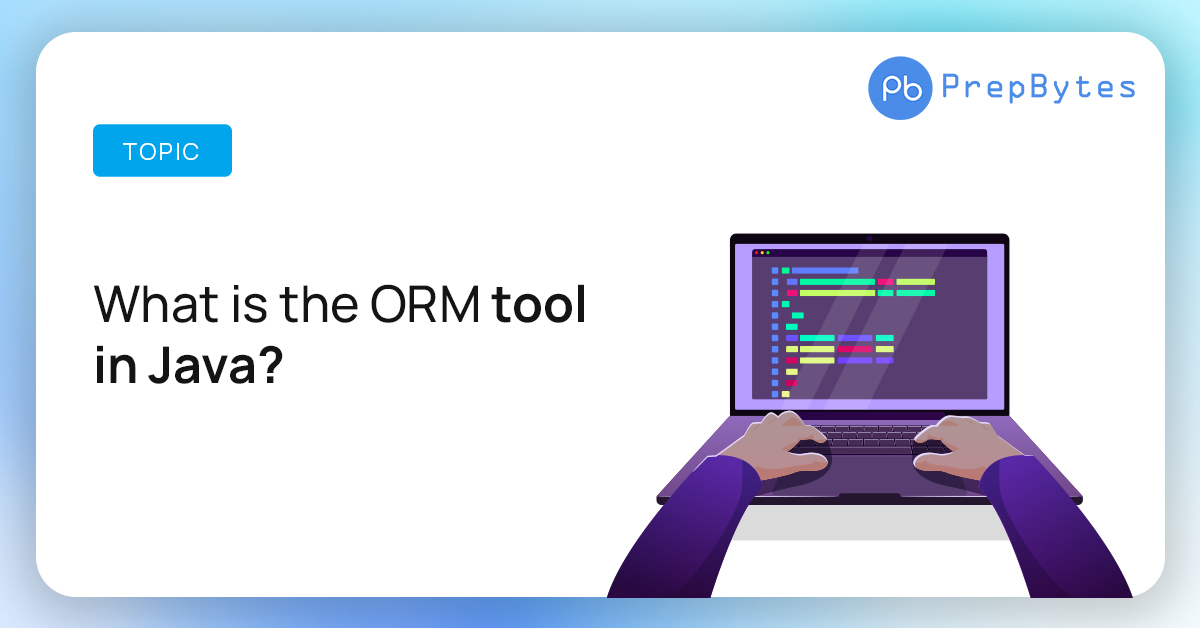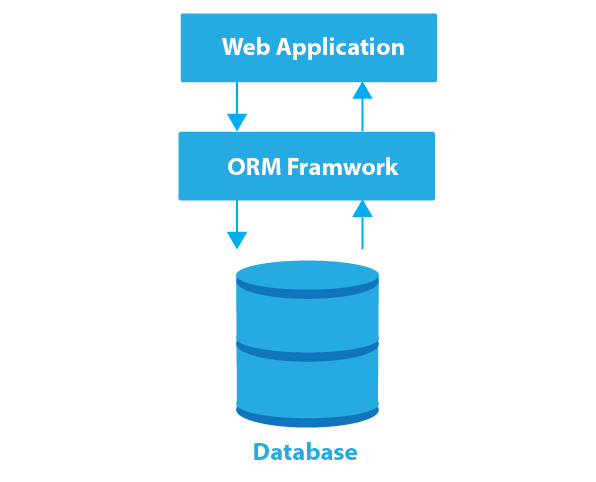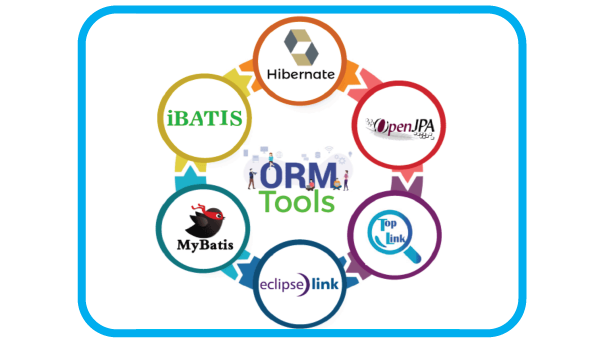ORM in Java stands for Object-Relational Mapping, and refers to a middleware application or tool positioned between a web application and a database. Its primary function is to encapsulate the implementation-specific intricacies of storage drivers within an API.
What is the ORM tool in Java?
ORM tool in Java is an acronym for Object-Relational Mapping, which is a method used to facilitate the conversion of data between Java objects and relational databases, specifically tables. In simpler terms, ORM in Java handles the task of mapping objects to the relational model and vice versa. This mapping is performed by the ORM tool in such a manner that the model class is transformed into a database table, and each instance of the class corresponds to a row within that table.
Advantages of ORM Tool in Java
ORM tools in Java offer several advantages in software development:
- Simplified Database Interaction: ORM tools abstract away the complexities of database interaction, allowing developers to work with objects and classes rather than writing raw SQL queries. This simplifies the coding process and enhances productivity.
- Increased Productivity: ORM tools automate many repetitive tasks involved in database operations, such as mapping objects to database tables, generating SQL statements, and handling database connections. This automation saves time and effort, boosting developer productivity.
- Database Portability: ORM tools provide a level of abstraction that helps achieve database portability. Developers can write code that is independent of specific database vendors, as the ORM handles the translation of object-oriented code to the appropriate database-specific SQL syntax.
- Maintenance and Flexibility: With an ORM, changes to the database schema can be managed more easily. The ORM tool can handle schema migrations and updates, reducing the maintenance effort required when making changes to the application’s data model.
- Performance Optimization: ORM tools often incorporate performance optimization techniques, such as caching, lazy loading, and query optimization. These optimizations help enhance the overall performance of database operations and improve the application’s responsiveness.
- Object-Oriented Programming Paradigm: ORM tools enable developers to work in an object-oriented paradigm, leveraging the benefits of encapsulation, inheritance, and polymorphism. This allows for better code organization, reusability, and maintainability.
- Testing and Mocking: ORM tools often provide built-in mechanisms for testing and mocking database operations. This makes it easier to write unit tests for the application’s data layer and simulate different scenarios without requiring a live database connection.
What are ORM Tools?
Among the multitude of available ORM tools, the following are widely utilized and commonly favored in software development.
- Hibernate
- TopLink
- EclipseLink
- OpenJPA
- MyBatis (formally known as iBatis)
Hibernate
Hibernate, an open-source and widely adopted lightweight ORM tool, serves as a Java persistence framework. It streamlines the process of Java application development by facilitating interaction with databases. Hibernate implements the Java Persistence API (JPA) specifications, enabling seamless data persistence in Java applications.
Advantages of Hibernate
Below are some Advantages of Hibernate:
- This ORM tool is not only open source but also lightweight, flexible, and highly robust.
- It offers support for database-independent queries through its unique HQL (Hibernate Query Language) feature.
- Its remarkable performance is attributed to its internal caching mechanism. Additionally, it simplifies the handling of complex joins.
- When modifications are made to tables or databases, it only requires changes to be made in the XML file properties, resulting in a streamlined process.
TopLink
Developed specifically for Java developers, TopLink is an ORM tool created by Oracle. It serves as a persistence framework integrated within Oracle’s OracleAS, WebLogic, and OC4J servers. TopLink offers a range of development tools and runtime functionalities that simplify the development process and enhance functionality. By storing persistent object data in relational databases, it facilitates the creation of high-performance applications. Additionally, it provides the capability to store data in either XML (Extensible Markup Language) or relational databases by transforming it from object-oriented data.
Advantages of TopLink
Here are some Advantages of TopLink:
- Enhanced Performance: TopLink incorporates efficient caching mechanisms and optimization techniques, resulting in improved performance for data access and retrieval operations.
- Database Independence: It allows for the development of database-independent applications, enabling seamless migration across different database platforms without requiring significant code changes.
- Flexible Mapping Options: TopLink provides a wide range of mapping options, allowing developers to map complex object models to relational databases with ease. It supports various mapping types and offers flexibility in defining relationships and constraints.
- Development Productivity: The tool offers a graphical user interface (GUI) that simplifies the process of defining object-relational mappings. This GUI interface streamlines development tasks, saves time, and enhances developer productivity.
- Business Logic Integration: TopLink enables the incorporation of business logic directly into the object model, allowing for the implementation of complex business rules and validations within the ORM layer itself.
OpenJPA
Apache OpenJPA, an initiative under The Apache Software Foundation, is a Java persistence project capable of functioning as an independent persistence layer for Plain Old Java Objects (POJOs). Furthermore, it seamlessly integrates with various Java EE-compliant containers and numerous lightweight frameworks, including Tomcat and Spring
Advantages of OpenJPA
- Persistence Flexibility: OpenJPA provides flexible persistence options, allowing developers to seamlessly integrate it as a stand-alone persistence layer or integrate it with Java EE-compliant containers and lightweight frameworks. This flexibility enables developers to choose the approach that best suits their application requirements.
- JPA Compliance: OpenJPA adheres to the Java Persistence API (JPA) specification, which is a widely adopted standard for object-relational mapping (ORM) in Java applications. This compliance ensures interoperability and portability, making it easier to switch between different JPA implementations.
- Transparent Persistence: OpenJPA offers transparent persistence, meaning developers can work with POJOs without writing complex SQL queries or dealing with low-level database operations. It handles the mapping between objects and the underlying database, simplifying the development process.
- Caching and Performance Optimization: OpenJPA includes built-in caching mechanisms that can significantly improve application performance. It supports various caching strategies, such as in-memory caching and distributed caching, which can minimize the number of database queries and reduce network overhead.
- Lazy Loading and Fetching: OpenJPA supports lazy loading and fetching strategies, allowing developers to optimize data retrieval and minimize unnecessary database operations. Lazy loading ensures that related objects are loaded only when accessed, improving performance and reducing memory consumption.
MyBatis
Originally called iBatis, MyBatis is an open-source persistence framework that streamlines the process of working with databases. In essence, it carries out the following four tasks:
- It executes SQL safely and abstracts away all the intricacies of JDBC.
- It maps parameter objects to JDBC-prepared statement parameters.
- It maps rows in JDBC result sets to objects.
MyBatis distinguishes itself from other Object-Relational Mapping (ORM) tools through its unique approach. The primary distinction between MyBatis and other ORM tools lies in the emphasis on SQL usage. Unlike other ORM tools that employ custom query languages like HQL (Hibernate Query Language), MyBatis prioritizes the direct use of SQL.
Advantages of MyBatis
Here are some advantages of MyBatis:
- Simplified Database Access: MyBatis simplifies the implementation of database operations by providing a straightforward and intuitive mapping between SQL statements and Java objects. It allows developers to write SQL queries directly, providing fine-grained control over the database access.
- Flexible Mapping: MyBatis offers flexible mapping options that allow developers to map database tables and columns to Java objects in a customizable manner. It supports various mapping techniques, including annotations and XML configuration, enabling developers to choose the approach that best fits their project requirements.
- Dynamic SQL Support: MyBatis provides dynamic SQL support, allowing developers to build SQL queries at runtime based on dynamic conditions. This flexibility is especially useful when dealing with complex and conditional queries, as it eliminates the need for writing multiple static queries.
- Performance Optimization: MyBatis offers performance optimization features to enhance database access speed. It supports caching mechanisms, which can significantly reduce the number of database round trips and improve overall application performance. MyBatis also provides features like lazy loading and result set streaming to minimize memory consumption.
- Integration with Existing Codebase: MyBatis can be seamlessly integrated into existing Java codebases without requiring significant changes to the application architecture. It works well with various frameworks and libraries, making it easy to incorporate MyBatis into projects with different technology stacks.
EclipseLink
EclipseLink, an offering by the Eclipse Foundation, is an open-source tool known as Eclipse Persistence Services. It serves as an extensible framework enabling Java developers to engage with a range of data services, including databases, web services, Object XML mapping, and enterprise information systems. EclipseLink boasts support for the following four persistence standards:
- JPA (Jakarta Persistence)
- JAXB (Jakarta XML Bindings)
- JCA (Jakarta Connectors)
- SDO (Service Data Object)
Advantages of EclipseLink
Advantages of EclipseLink are listed below:
- Comprehensive Persistence Solution: EclipseLink provides a comprehensive set of features and capabilities for managing persistence in Java applications. It supports a wide range of persistence standards, including Java Persistence API (JPA), Java Connector Architecture (JCA), Service Data Objects (SDO), and Object XML Mapping (OXM). This versatility allows developers to handle various data sources and integration scenarios effectively.
- High Performance: EclipseLink is renowned for its high-performance capabilities. It includes advanced caching mechanisms, connection pooling, and query optimization techniques that help optimize data access and minimize database round trips. These performance optimizations contribute to improved application response times and scalability.
- Advanced Mapping and Relationship Support: EclipseLink offers flexible and robust mapping options for mapping Java objects to relational databases and other data sources. It supports a wide range of mapping strategies, including annotations, XML configuration, and even dynamic mapping. EclipseLink also provides comprehensive support for managing relationships between entities, including one-to-one, one-to-many, and many-to-many relationships.
- Integration with Java EE Ecosystem: EclipseLink seamlessly integrates with the Java EE ecosystem, making it an ideal choice for Java Enterprise Edition (Java EE) applications. It integrates well with application servers, such as Apache Tomcat, Oracle WebLogic, and IBM WebSphere. EclipseLink also supports Java EE features like container-managed persistence contexts, transaction management, and declarative security.
- Flexible and Extensible Architecture: EclipseLink follows a modular and extensible architecture, allowing developers to customize and extend its functionality as per their specific requirements. It provides extension points and APIs for adding custom converters, validators, event listeners, and other customizations. This flexibility ensures that EclipseLink can adapt to different application needs and integrate seamlessly with existing codebases.
Conclusion
In conclusion, an Object-Relational Mapping (ORM) tool in Java is a software framework that simplifies the interaction between a Java application and a relational database. It provides a mapping mechanism to convert Java objects into database entities and handles the underlying database operations, such as querying, inserting, updating, and deleting data. ORM tools offer advantages like increased productivity, code simplicity, database portability, and performance optimizations. Popular ORM tools in the Java ecosystem include Hibernate, Apache OpenJPA, MyBatis, and EclipseLink.
FAQs related to What is the ORM tool in Java
Frequently asked questions related to ORM tool in Java are given below:
Q1. Why should I use an ORM tool in my Java application?
Using an ORM tool in a Java application offers several benefits. It eliminates the need for writing complex SQL queries, reduces boilerplate code, enhances productivity, improves code maintainability, and provides database portability across different platforms and vendors.
Q2. Which ORM tool should I choose for my Java project?
The choice of an ORM tool depends on various factors such as project requirements, performance needs, and developer familiarity. Hibernate is a widely adopted ORM tool with extensive features, while Apache OpenJPA and EclipseLink offer JPA compliance. MyBatis is suitable for developers who prefer working with SQL directly.
Q3. Can I switch between different ORM tools in Java application?
Yes, it is possible to switch between different ORM tools in Java, but it may require some effort to modify the code and mapping configurations. However, the Java Persistence API (JPA) standardizes the ORM interface, making it easier to switch between JPA-compliant ORM tools.
Q4. Do ORM tools affect performance in Java applications?
ORM tools can have an impact on performance, but modern ORM frameworks provide various performance optimization techniques such as caching, lazy loading, and query optimizations. Careful configuration and usage of these features can help mitigate any potential performance concerns.
Q5. Can I use an ORM tool with non-relational databases?
ORM tools are primarily designed for relational databases. However, some ORM tools, like Hibernate OGM, offer extensions or modules that support non-relational databases, allowing developers to work with NoSQL databases alongside traditional relational databases.





